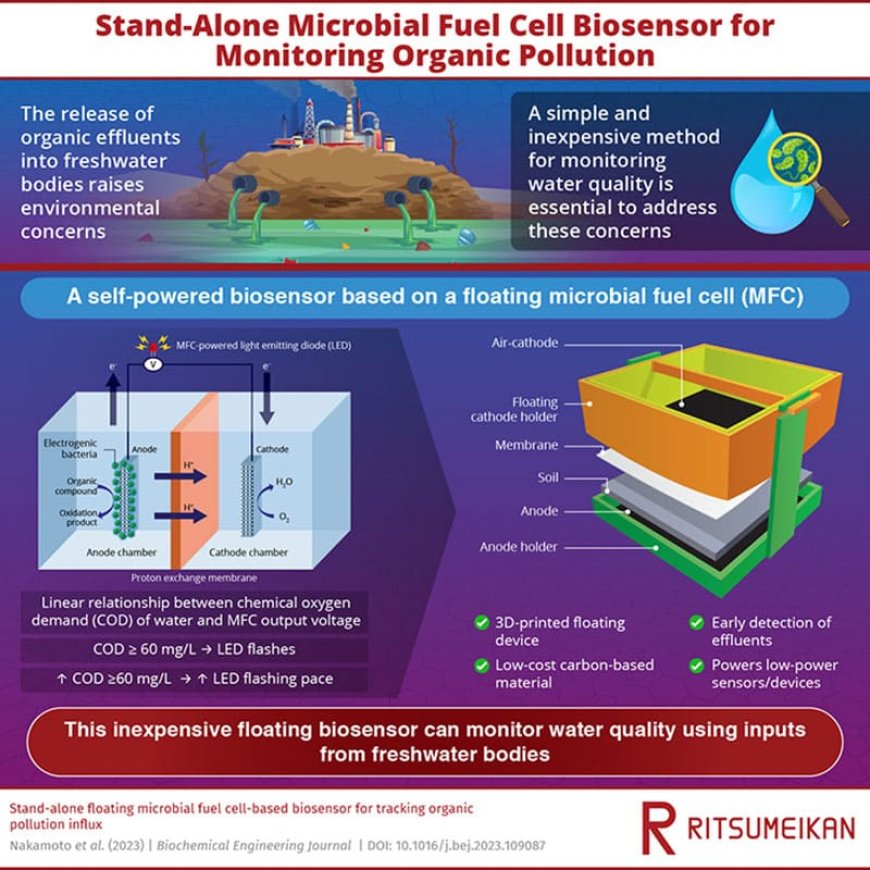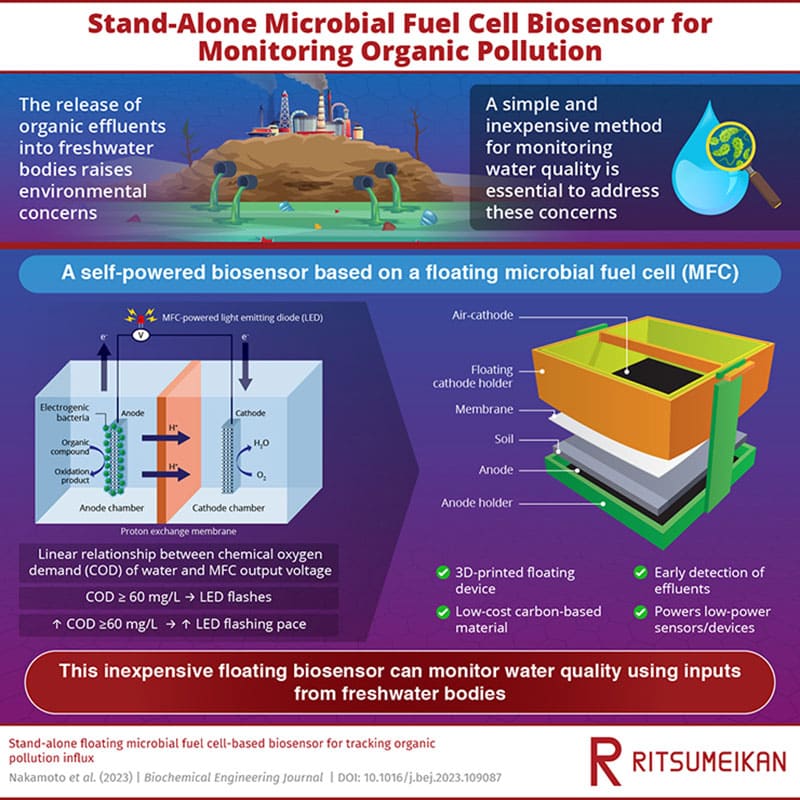Self-powered, low-cost biosensor for monitoring freshwater ecosystems
Self-powered, low-cost biosensor for monitoring freshwater ecosystems Tech Explorist

Organic Effluents and Water Quality Monitoring: A Breakthrough in Sustainable Development
Organic effluents discharged into freshwater bodies are a major concern for the health and sustainability of aquatic ecosystems. Organic effluents refer to any biodegradable material produced from the remains of plants and animals.
Unfortunately, the available methods used for water quality monitoring are complex, expensive, time-consuming, and require advanced technician skills, making it difficult to address this problem effectively.
A Self-Powered Biosensor for Water Quality Monitoring
In a remarkable breakthrough, researchers from Ritsumeikan University, Japan, have developed a self-powered, inexpensive, and floating biosensor for monitoring water quality at the input of freshwater lakes and rivers.
“We developed a self-powered, stand-alone, floating biosensor based on a microbial fuel cell (MFC) for early organic wastewater detection,” said Kozo Taguchi, a professor in the College of Science and Engineering’s Department of Electrical and Electronic Engineering at Ritsumeikan University and leader of the study. “The MFC case was fabricated by a 3D printer, and the electrodes were fabricated from low-cost carbon-based materials.”
The Power of Microbial Fuel Cells
The microbial fuel cell (MFC) can generate electricity based on the biological bio-electric conversion capability of electrogenic bacteria – like Geobacter, Shewanella, and Pseudomonas – inside the cell. They consume organic matter in water and release electrons to the anode of the MFC.
The amount of electricity generated by the fuel cell is proportionate to the amount of waste that is being consumed by the electrogenic microorganisms – which means that the power source itself acts as the sensor.

An Innovative Solution for Monitoring Water Quality
The team’s prototypes are based on inexpensive carbon-based materials and are designed to float along a river or on a lake surface. When the soil containing electrogenic bacteria decomposed the organic matter in the water, they converted the stored chemical energy into electricity. This electrical output was then used as a measure of the organic waste present in the contaminated water, providing a direct and efficient method of monitoring water quality.
The researchers improved the practicality of the biosensor used for monitoring freshwater ecosystems by adding a light-emitting diode (LED) to the floatable biosensor assembly. This LED was able to utilize the electricity generated by the electrogenic bacteria to indicate the level of organic contamination in the water samples.
The LED would start flashing when the chemical oxygen demand (COD) of the water sample exceeded the threshold value of 60 mg/L and would flash at an increased pace when the COD exceeded the threshold value considerably. This visual cue provided by the LED is a simple yet effective way for anyone to understand the level of contamination in the water without requiring complex analysis.
Contributing to Sustainable Development Goals
Additionally, the FMFC biosensor produces its own electricity; it requires no external power supply, making it a self-sustaining solution for monitoring water quality. This feature makes it particularly useful in early detection systems that monitor influxes of organic wastewater in freshwater bodies. The biosensor can provide a timely warning, helping to prevent potential environmental disasters.
Conclusion
This breakthrough in water quality monitoring using a self-powered and inexpensive biosensor based on microbial fuel cells is a significant step towards achieving the Sustainable Development Goals (SDGs). By providing an efficient and accessible method for monitoring organic effluents in freshwater bodies, this technology contributes to SDG 6 (Clean Water and Sanitation) and SDG 14 (Life Below Water). It enables early detection and prevention of environmental disasters, promoting the health and sustainability of aquatic ecosystems.
Journal reference:
- Trang Nakamoto, Dung Nakamoto, Kozo Taguchi. Stand-alone floating microbial fuel cell-based biosensor for tracking organic pollution influx. Biochemical Engineering Journal, 2023; DOI: 10.1016/j.bej.2023.109087New window
SDGs, Targets, and Indicators Analysis
1. Which SDGs are addressed or connected to the issues highlighted in the article?
- SDG 6: Clean Water and Sanitation
- SDG 9: Industry, Innovation, and Infrastructure
- SDG 14: Life Below Water
The article discusses the issue of organic effluents discharged into freshwater bodies, which is directly related to SDG 6 – Clean Water and Sanitation. It also highlights the development of a self-powered biosensor, which falls under SDG 9 – Industry, Innovation, and Infrastructure. Lastly, the biosensor’s purpose of monitoring water quality in freshwater lakes and rivers aligns with SDG 14 – Life Below Water.
2. What specific targets under those SDGs can be identified based on the article’s content?
- SDG 6.3: Improve water quality by reducing pollution, eliminating dumping, and minimizing release of hazardous chemicals and materials.
- SDG 9.5: Enhance scientific research, upgrade technological capabilities of industrial sectors, and promote innovation.
- SDG 14.1: Prevent and significantly reduce marine pollution of all kinds, particularly from land-based activities.
The article’s content suggests that the biosensor can contribute to achieving SDG 6.3 by providing a more efficient method of monitoring water quality and detecting organic pollution in freshwater bodies. It also supports SDG 9.5 by showcasing an innovative and low-cost solution for water quality monitoring. Additionally, the biosensor’s application in monitoring organic contamination in freshwater aligns with SDG 14.1’s goal of reducing pollution from land-based activities.
3. Are there any indicators mentioned or implied in the article that can be used to measure progress towards the identified targets?
- Chemical Oxygen Demand (COD) level in water samples
- Flashing LED indicating the level of organic contamination
The article mentions the use of the Chemical Oxygen Demand (COD) level in water samples as an indicator of organic waste present in the contaminated water. The biosensor’s LED flashing at different paces depending on the COD level provides a visual cue to understand the level of contamination. These indicators can be used to measure progress towards achieving the identified targets by monitoring and assessing the effectiveness of the biosensor in detecting and tracking organic pollution influx.
SDGs, Targets, and Indicators Table
| SDGs | Targets | Indicators |
|---|---|---|
| SDG 6: Clean Water and Sanitation | 6.3: Improve water quality by reducing pollution, eliminating dumping, and minimizing release of hazardous chemicals and materials. | – Chemical Oxygen Demand (COD) level in water samples – Flashing LED indicating the level of organic contamination |
| SDG 9: Industry, Innovation, and Infrastructure | 9.5: Enhance scientific research, upgrade technological capabilities of industrial sectors, and promote innovation. | – Flashing LED indicating the level of organic contamination |
| SDG 14: Life Below Water | 14.1: Prevent and significantly reduce marine pollution of all kinds, particularly from land-based activities. | – Chemical Oxygen Demand (COD) level in water samples – Flashing LED indicating the level of organic contamination |
Behold! This splendid article springs forth from the wellspring of knowledge, shaped by a wondrous proprietary AI technology that delved into a vast ocean of data, illuminating the path towards the Sustainable Development Goals. Remember that all rights are reserved by SDG Investors LLC, empowering us to champion progress together.
Source: techexplorist.com

Join us, as fellow seekers of change, on a transformative journey at https://sdgtalks.ai/welcome, where you can become a member and actively contribute to shaping a brighter future.







